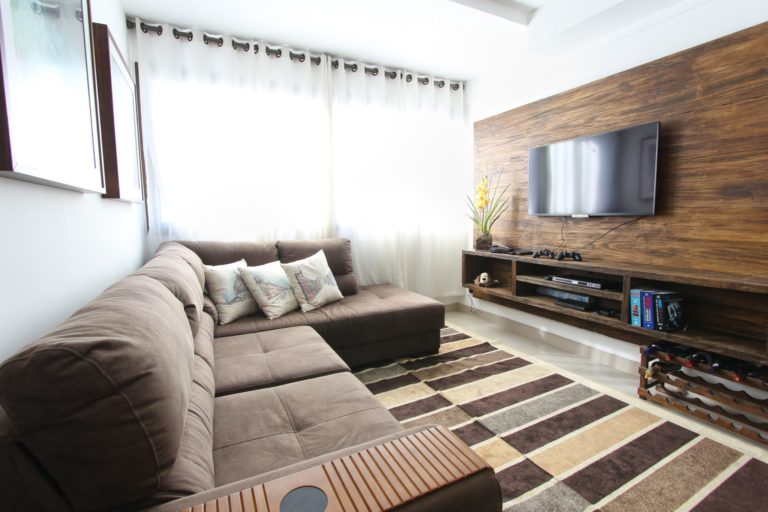In the last five years hanging TV’s has become very popular. Who would have thought that someday those tubes sitting on entertainment centers would end up on the wall? Really the only place I ever recall TV’s hanging when I was a kid was in hospital rooms. That’s probably not the place where you want to experience TV’s up and out of the way. TV’s continue to get cheaper each year as technology changes. Lately it seems 65” TV’s are all the rage.
Hanging a TV properly is very important! Failure to do so will have your TV crashing in the middle of the night scaring you half to death. Here are some items to be mindful of when you decide to get that TV up in the air.
Wall Location
Typically the location of your TV will be determined by where you want your sofa or bed located in the room. Most of the time this wall is composed of drywall and mounting the TV is straightforward. If on the other hand, the TV will be mounted on a block or concrete wall, special fasteners must be used. Try to find a location where two wall studs can be used to mount the TV. If two studs cannot be found at least one stud should be used for one side of the mount. The other side can use special drywall fasteners.
If a wire hide kit is part of the installation for your TV, it is better to choose an interior wall. By choosing an interior wall you will not have to fight insulation and you reduce the possibility of running into a fire block in the wall.
TV Mount Style
There are several types of mounts available for hanging TV’s. Three of the most common will be discussed here. Overall is it best if the mount purchased is wide enough to catch at least two wall studs. This means that the mounting holes on the mount should be at least 16” apart. If the mount is made to attach to a single stud this is no longer an issue. For large TV’s 40” and above, I recommend a mount that attaches to two studs.
Tilt Mount– This is your most basic mount. It allows the TV to tilt down several degrees to make it more comfortable watching the screen. I like this mount because they are typically wide enough to catch two studs allowing for a more secure installation. These are also the least expensive of the mounts
Full Motion Double Mount– This type of mount allows full motion of the TV. It allows the TV to rotate left and right as well as tilt. These mounts are nice for entertaining purposes as they can be pointed toward the location of a crowd in a home. This could be the living room but might also be a kitchen area. Some of these also allow the TV to slide left to right. Similar to the tilt mount, most of these are wide enough to catch two studs but I have installed some that are not. Check into this before making your final purchase. These tend to be the most expensive mounts.
Full Motion Single Mount– This mount operates similar to the double mount. The only difference is that it is designed to mount to a single stud in the wall. Due to this feature these mounts are usually rated for smaller TV’s.
Wall Anchoring
TV mounts usually come with the proper hardware for attaching the mount to the wall when all conditions are ideal. If they are not ideal you will have to figure out another way of attaching the mount. Here are some great videos discussing types of anchors to use in drywall and concrete. If you are an avid DIY person I highly recommend subscribing to Leah’s channel. She does an amazing job explaining how to do repairs.
Drywall anchors- https://www.youtube.com/watch?v=Bgrad5eC3y8
Concrete anchors- https://www.youtube.com/watch?v=-v7FujAXg4Q&t=214s
Lag Bolts- Using lag bolts is the easiest way to attach your mount to the wall. These are designed to for walls built with wood studs. Walls built with steel studs cannot use these fasteners. It is highly recommended that holes for lag bolts be predrilled before installation. Instructions for the TV mount will say which drill bit diameter to use for the bolts they supply.
Snap Toggles Bolts- Snap toggles are an amazing invention! I am delighted that someone designed these bolts. These take the place of the old style toggle bolts with small wings. The wings expanded in the wall once pushed through the hole. The problem with regular toggle bolts is that they are a onetime use fastener. When you reverse the screw, the nut falls in the wall and must be replaced. This is not the case for snap toggles! These fasteners are a must use for a TV mount when one side of the mount cannot be attached to a stud in the wall. These should also be used if walls were built with steel studs or the mount is going into a concrete block wall.
Concrete Anchors- There a variety of ways to attaching mounts to concrete walls or blocks. Attaching mounts to a solid brick or concrete wall can be tough but the best solution is to use wedge anchors. These are designed to be hammered into a predrilled hole in concrete. As the nut is tightened the bolt wedges itself to the sides of the hole preventing it from pulling out. Mounting TV’s in concrete requires specialized equipment and is usually outside the skill set of most homeowners.
Wire Hiding
There are as many wire hide kits as there are TV mounts. You will have to decide what works best for you and your goals. However, there are some kits that are better than others, and some that follow building codes while others do not. Some wire hide kits use an extension style cord inside the wall to take power up to the plug behind the TV. This is not legal is most areas. Extension cords are not to be placed behind walls because there is high voltage running in the cord. That is why I recommend and install this wire hide kit that can be found here on Amazon. https://www.amazon.com/Legrand-Q-Wall-Clutter-Free-Installation/dp/B00GDTZDVS/ref=sr_1_6?keywords=legrand+tv+wire+hide+kit&qid=1576447519&sr=8-6
This kit uses ROMEX wire from the bottom plug to the top plug in the wall. This is the same type of wire that supplies power throughout your home. This wire is designed to carry the 120 volts to your TV. I also like this kit because it has two power outlets behind the TV which allows for a sound bar or other powered option to be installed later on. The HDMI and other low power wires can be run through the wall without a problem. This kit has openings to allow running these additional cables.
As mention previously, choosing an interior wall will typically reduce the amount of work necessary to run the wires. Most interior walls do not have insulation or fire blocks. Exterior walls typically have both of these items. Running wires through the wall with insulation can be a hassle. Fish tape can be used to help pull the wires though the holes in the wall made for the wire hide kit. Lastly, if a fire block is encountered in the wall it will be necessary to cut another hole in the drywall above the fire block. This will allow a hole to be drilled through the fire block and wires to pass through.
TV wall mounting can be a great way to change the look of a room. With a couple of power tools and an afternoon you can get your TV up and out of the way!









